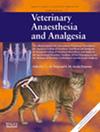肌肉注射美托咪定与美托咪定-维替诺森镇静在胡须龙(pogonaviticeps)中的比较。
IF 1.4
2区 农林科学
Q2 VETERINARY SCIENCES
引用次数: 0
摘要
目的:比较肌肉注射美托咪定与美托咪定-维替诺散对大胡子龙的镇静作用。研究设计:前瞻性、随机、实验性、交叉研究。动物:10只(雄性5只,雌性5只)胡须龙(平均质量±标准偏差172±28 g)。方法:所有动物均给予美托咪定(0.2 mg kg-1) (MED)和美托咪定(0.2 mg kg-1)-瓦替诺散(4 mg kg-1) (MED- vat) IM,两次治疗之间有14-16 d的洗脱期。在给药前(T0)和给药后10- 45分钟(T10-T45)每5分钟使用一种改版的胡须龙镇静量表(量表范围0-12)评估镇静作用。镇静评分比较:1)使用Friedman检验和Dunn事后检验在不同时间点(治疗内)之间进行比较;2)使用Wilcoxon配对检验在每个时间点的治疗之间。描述性分析心率和呼吸率(fR)。T45时给予阿替帕唑IM。结果:与T0相比,两组患者镇静评分在大部分时间点均显著升高。MED的最高中位(范围)评分出现在T30 [t0,0 (0-0)];t30,2.5 (1-5);p = 0.0001]和T35和T40的MED-VAT [t0,0 (0-0)];t35,2 (1-5);P = 0.002;t40,2 (1-5);P = 0.001]。两组在任何时间点的镇静评分均无显著差异。两种方案均引起心动过缓和fR降低。所有动物在逆转给药后1小时恢复活动和进食。结论及临床意义:美托咪定和美托咪定-瓦替诺散对大胡子龙的镇静作用相似(中位数< 3/12)。vatinoxan的加入并没有增强该物种的镇静作用。本文章由计算机程序翻译,如有差异,请以英文原文为准。
Comparison of intramuscular medetomidine versus medetomidine-vatinoxan sedation in bearded dragons (Pogona vitticeps)
Objective
To assess sedation following intramuscular (IM) administration of medetomidine versus medetomidine–vatinoxan in bearded dragons.
Study design
Prospective, randomized, experimental, crossover study.
Animals
A group of 10 (five males and five females) bearded dragons (mean mass ± standard deviation 172 ± 28 g).
Methods
All animals were administered both medetomidine (0.2 mg kg–1) (MED) and medetomidine (0.2 mg kg–1)-vatinoxan (4 mg kg–1) (MED-VAT) IM, with a 14–16 day washout period between treatments. Sedation was assessed using an adapted version of a sedation scale for bearded dragons (scale range 0–12) before (T0), and every 5 minutes from 10 to 45 minutes after treatment administration (T10–T45). Sedation scores were compared: 1) between time points (within treatments) using a Friedman test and Dunn’s post hoc test; and 2) between treatments at each time point using a Wilcoxon paired test. Heart rate and respiratory rate (fR) were analyzed descriptively. At T45, atipamezole was administered IM.
Results
Compared with T0, sedation scores were significantly higher at most time points for both treatments. Highest median (range) scores occurred at T30 for MED [T0, 0 (0–0); T30, 2.5 (1–5); p = 0.0001] and at T35 and T40 for MED-VAT [T0, 0 (0–0); T35, 2 (1–5); p = 0.002; T40, 2 (1–5); p = 0.001]. No significant differences in sedation scores were identified between treatments at any time point. The two protocols caused bradycardia and reduction in fR. All animals were active and ate 1 hour after reversal administration.
Conclusions and clinical relevance
Both medetomidine and medetomidine–vatinoxan caused similar mild sedation in bearded dragons (median < 3/12). Inclusion of vatinoxan did not enhance sedation in this species.
求助全文
通过发布文献求助,成功后即可免费获取论文全文。
去求助
来源期刊

Veterinary anaesthesia and analgesia
农林科学-兽医学
CiteScore
3.10
自引率
17.60%
发文量
91
审稿时长
97 days
期刊介绍:
Veterinary Anaesthesia and Analgesia is the official journal of the Association of Veterinary Anaesthetists, the American College of Veterinary Anesthesia and Analgesia and the European College of Veterinary Anaesthesia and Analgesia. Its purpose is the publication of original, peer reviewed articles covering all branches of anaesthesia and the relief of pain in animals. Articles concerned with the following subjects related to anaesthesia and analgesia are also welcome:
the basic sciences;
pathophysiology of disease as it relates to anaesthetic management
equipment
intensive care
chemical restraint of animals including laboratory animals, wildlife and exotic animals
welfare issues associated with pain and distress
education in veterinary anaesthesia and analgesia.
Review articles, special articles, and historical notes will also be published, along with editorials, case reports in the form of letters to the editor, and book reviews. There is also an active correspondence section.
 求助内容:
求助内容: 应助结果提醒方式:
应助结果提醒方式:


